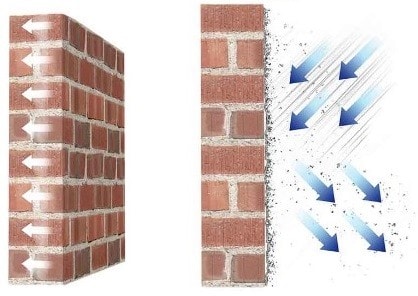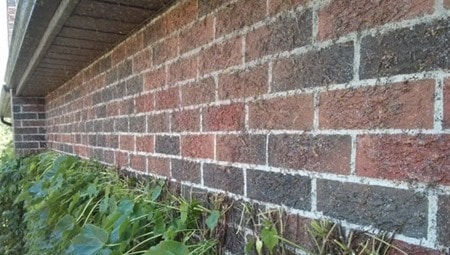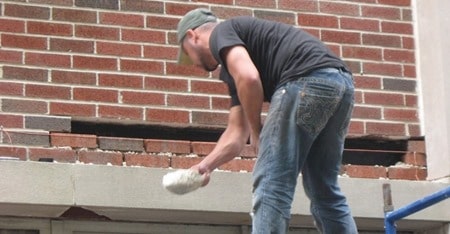Methods to Prevent Water Penetration in Brick Masonry Walls
How to Prevent Water Penetration in Brick Masonry Walls?
Water penetration into brick masonry walls leads to several problems such as efflorescence, mortar joint deterioration, interior moisture damages and spalling. Methods to prevent water penetration into masonry walls are discussed.
When brick wall masonry structure experiences one or more issues related to water penetration, then it would be required to not only eliminate the source of water ingression but also deal with the deteriorated region of the wall.

Fig.1: Water Penetrates Masonry Wall

Fig.2: Water Penetrates Masonry Wall
Methods to Prevent Water Penetration in Brick Masonry Walls
Maintenance techniques for elimination of moisture penetration are as follows:
- Replacement of sealant of joints in masonry wall
- Grouting of mortar joints
- Tuck pointing mortar joints
- Ivy removal
- Opening weep holes
- Replacement of deteriorated masonry walls
- Installation of damp proof course
- Installation of flashing
Replacement of Sealant of Joints in Masonry Wall
When sealants at expansion joints and between brick masonry wall and other elements such as door frames and windows are damaged, then water would easily penetrates the wall though these areas in which sealants are deteriorated.
So, it is recommended to regularly inspect brick masonry wall to find out whether the sealant is sound, falling out of their position, or deteriorated.
If the joint sealant is damaged or falling off its position, then new sealant should be installed to prevent moisture penetration.
Figure 3 shows deteriorated sealant between framing window and brick masonry in figure (A), the joint repaired though the placement of new sealant in (B).

Fig.3: (A) Deteriorated Sealant Between Brick Masonry and Framing Wind, (B) New Sealant Installed
Grouting of Mortar Joints in Masonry Walls
Mortar joints suffers from hairline cracks and hence water could penetrate the brick masonry wall through these cracks. To tackle this problem, it is recommended to apply grouting to seal cracks in mortar joints.
Initially, mortar joints are wetted to ensure good bond between mortar and applied grout, then the grout is applied to the mortar surface using strong fiber brush to force grouting into the cracks.
Tuck Pointing Mortar Joints
Mortar joint deterioration, softening or initiation of noticeable crack would allow water penetration into masonry wall. These defects should be repaired to counteract water penetration.
It is recommended to remove damaged mortar from the joint and pour new into the joint. This process is called tuck pointing.
Tuck pointing should be conducted by skilled and experienced persons to seal the joint adequately and prevent possible brick damages during mortar removal.
Figure-4 explains tuck pointing mortar joints; (1) Deteriorated mortar joint, (2) Removed damaged mortar to a uniform depth, (3) Place mortar in thin layers and (4) Apply suitable tool to reach the original level.

Fig.4: Sequence of Tuck Pointing Mortar Joints
Ivy Removal to Prevent Water Penetration in Masonry Walls
Sometimes ivy may increase the possibility of water penetration into masonry walls especially in the case where ivy shoots penetrate voids in mortar. Therefore, it is necessary to remove ivy to prevent moisture penetration.
When ivy shoots are removed, they should be cut and removed after drying which may take less than a month. If mortar joint cracked or damaged in this process, tuck pointing should be applied.

Fig.5: Ivy on Surface of Brick Masonry Wall
Opening Weep Holes in Masonry Walls
Occasionally, water within brick masonry wall does not have proper drain path and consequently remain inside the wall. This is because the weep holes are poorly spaced or debris have stopped weep hole to function properly.
This problem can be solved by introducing new weep holes or cleaning weep holes using suitable means.

Fig.6: Clogged Weep Hole Needs Cleaning in Masonry Wall
Replacement of Deteriorated Masonry Walls
Moisture would ingress into cracked and spalled masonry units. In this case, deteriorated masonry should be removed and new brick units should be placed.
The process of brick replacement involves the removal of mortars with chisels, break masonry unit, clean the place of deteriorated masonry unit, wet the surface of brick masonry and finally the brick will be positioned on its original position and excess mortar will be removed.

Fig.7: Removal and Placement of Deteriorated Masonry Wall
Installation of Damp Proof Course
Water within masonry wall might move upward to the higher places of the wall. This can be prevented by installing damp proof course in the masonry walls.
There are two methods for the placement of damp proof course. Firstly, insertion of a chemical damp proof layer into a masonry wall. Secondly, removing the whole brick course, after that both damp proof layer and break masonry units are installed.
Installation of Flashing
Flashings may become a source for water penetration into the interior of masonry building if they are damaged, poorly placed or omitted. This problem cannot be answered unless brick masonry is removed, new flashing is placed and finally installing new masonry bricks if it is necessary.
Comments